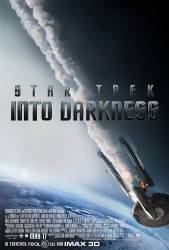Factual error: After the USS Vengeance blasts the USS Enterprise out of Warp, Sulu says that they are 237,000km away from Earth, but the Moon is between both ships and Earth. Earth's Moon is about 380,000km away from our planet, so the Moon should have been way behind the combatants.

Star Trek Into Darkness (2013)
Directed by: J.J. Abrams
Starring: Benedict Cumberbatch, Simon Pegg, Chris Pine, Karl Urban, Zoe Saldana, Anton Yelchin, Alice Eve, John Cho, Zachary Quinto
Factual error: At one point Khan threatens to target the Enterprise's life support systems which are located behind her "aft nacelle". The Enterprise doesn't have an aft nacelle; as the many exterior shots show, it has a port nacelle and a starboard nacelle. Khan a) is familiar enough with Starfleet ships to know this basic fact about the Enterprise, and b) can see its nacelles for himself on his own viewscreen while he's delivering this line. There is no "nacelle" housing the impulse engines. They are enclosed by the hull of the saucer section. (01:37:25)
Factual error: Enterprise and Vengeance come out of warp near the moon, 237,000km from Earth. Due to their altercation. They lose power and proceed to fall freely toward Earth. The scene plays as though it takes a matter of a few minutes, too fast to get the situation under control. At that distance, the gravity acceleration from Earth would only be .01 m/sec/sec. This means that they should have had approximately 2.52 days before crashing, especially given their apparent relative stop as per the visible moon.
Trivia: As Kirk, Spock, and Uhura head to the shuttle bay for their mission to Kronos to capture Khan, Sulu orders crew to prepare the vessel that was confiscated in the Mudd incident. This is a reference to Harry Mudd, a roguish character who appeared in the original Star Trek series in the episodes titled,"I, Mudd" and "Mudd's Women." Harry Mudd, played by Roger C. Carmel, was the only non-regular character to appear in more than one episode on the original Star Trek series. Carmel was slated to reprise the role in Star Trek: TNG, but he died before the episode could be filmed. (00:44:25)
Trivia: The library that is bombed is called the "Kelvin Memorial Archive," a reference to the destruction of the U.S.S. Kelvin seen in the first film. (00:18:05)
Christopher Pike: Are you giving me attitude, Spock?
Spock: I'm expressing multiple attitudes simultaneously, Sir. To which are you referring?
Bones: Jim, you just sat that man down at a high-stakes poker game with no cards and told him to bluff. Now, Sulu's a good man, but he's no captain.
James T. Kirk: For the next two hours, he is. And enough with the metaphors, all right? That's an order.
Bones: Jim, you're not actually going after this guy, are you?
James T. Kirk: I have no idea what I'm supposed to do, I only know what I can do.
Question: Why does Khan have to be alive for McCoy to use his blood to save Kirk? The blood will be removed from its supply anyway when drawn.
Chosen answer: McCoy has no real idea how much blood he's going to need to bring Kirk back - given the catastrophic radiation damage to his body, there's every possibility that he might need multiple transfusions over a period of time, which would be much easier if Khan was still alive. Plus there's also the issue that killing Khan could well involve spilling some of the blood that McCoy so desperately needs. Bringing Khan in alive is the best way to maximise their chances.
Question: When The Enterprise reaches Kronos, we see one of Krono's moons was half blown away long before the events of Into Darkness Take Place. In Star Trek VI: The Undiscovered Country, one of Kronos' moons blows half away in an "incident." That incident takes place later on in the lives of the characters when they come close to retirement in the previous reality before it was altered. Are we to assume that either: A different Kronos moon blew long before Star Trek VI in a similar fashion, or that the change of events from the previous film had such a strong butterfly effect that the Kronos moon suffered an incident much sooner than it originally had?
Chosen answer: The explosion of the Moon Praxis in the original Universe was due to extensive over mining and energy production. In the first movie that took place in the alternate reality, an entire Klingon armada was destroyed by the Narada. It is logical to assume that the Klingons began to over-mine the moon in order to obtain the resources necessary to replace so many lost ships, causing the moon to explode several decades before it happened in the Prime timeline.
Join the mailing list
Separate from membership, this is to get updates about mistakes in recent releases. Addresses are not passed on to any third party, and are used solely for direct communication from this site. You can unsubscribe at any time.
Check out the mistake & trivia books, on Kindle and in paperback.




Answer: Unless the cold fusion went directly into the volcano, all the way to the source of the pressure.